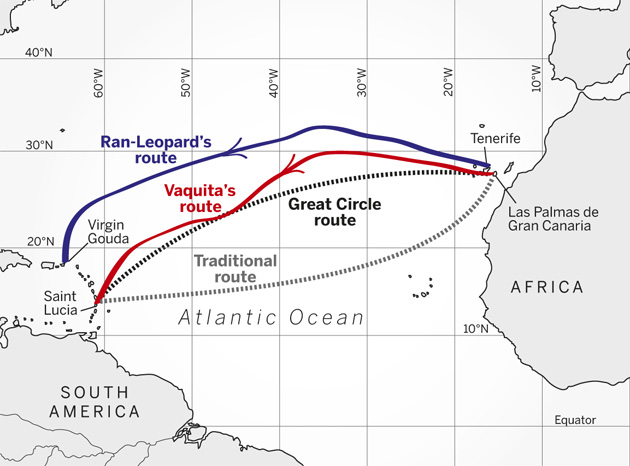Meteorologist Chris Tibbs deconstructs the ARC-winning northerly route across the Atlantic and explains why it comes with a caution for cruisers
In the 2012 Atlantic Rally for Cruisers the winning boats, the Class 40 Vaquita and the maxi Rán-Leopard, followed a similar route, which was suggested by routeing programs and made heading west a good option, but care needed to be taken as wave models indicated significant wave heights of up to 6m.
Rán-Leopard managed to stay in strong favourable wind on their passage. Below is a brief description of how they did it.
- A small low crossed the Canary Islands giving strong northerly winds, which gave good reaching conditions to the west.
- The Azores High was well to the north and, as it moved south, the Trades gave a strong north-easterly flow.
- By the time the low was developing mid-Atlantic they had managed to cross the track of the low, Rán-Leopard maintaining the strong breeze to the north of the low.
- They had enough power to transit the light wind zone west of the low and get into tradewinds strengthening from high pressure in the west Atlantic.
- There was wind to the north and an area of light wind extending from the low all the way to the Leeward Islands, which necessitated the somewhat extreme-looking course approaching the finish from the north.
Depression to dodge
Staying north continued to give stronger wind; however, there was the development of a small depression to dodge – at one time this was given a 50 per cent chance of developing into a tropical storm. Rán-Leopard was by this time well to the west, but an area of light wind kept them north.
For Vaquita, there was a period of light wind that made for a slow few hours, but as high pressure filled in from the north-west it was shorter than expected.
Forecasts have become more accurate over the years and the rapid increase in onboard routeing programs takes out a lot of the guesswork. But it is a case of ‘junk in junk out’: unless the polars are good and the forecasts accurate the solutions will be questionable. And what it cannot take into account is the confidence level in the forecast and the risk a skipper is prepared to take.
Rán-Leopard and Vaquita are high-performance racing yachts that can, with the right wind, keep ahead of weather systems. Their speed also gives them the advantage of being able to use a long-range forecast to cover the whole route.
Northerly route pros
- Can be shorter as it follows close to the Great Circle route.
- Generally the further north you go, the stronger (but more variable) the wind.
- Getting north of a low gives a strong favourable wind whereas to the south the wind will be lighter and more variable.
Cons
- The track of lows can vary between weather models or expectations change over time.
- Close to the south of the low will usually be light and variable wind while to the north can be strong to gale force.
- Strong and changing winds mean sea state can become large or even dangerous. In the ARC in 2005 a number of boats following the northerly route were damaged.
- Occasionally, named tropical storms develop mid-Atlantic. This year the small low early in December was given a 50 per cent chance of developing into a tropical storm by the National Hurricane Center (USA).
Advice for the ARC
The Great Circle or northerly route has the potential to be a race-winning one and it would be hard to envisage a record-breaking run to the south. But there is a risk and for most ARC crews an unnecessary one.
The majority of crews are looking for a fast downwind run, but also a pleasurable sail. Climatalogical records show the steadiest wind will be found by heading towards the Cape Verde Islands then flattening the route towards Saint Lucia. This is the relatively low-risk standard route.
By cutting the corner a shorter distance is covered, but sometimes there is a band of light wind mid-Atlantic from a trough of low pressure. This can give a period of headwinds on the more direct route, while boats to the south have tradewinds. The extra 100-150 miles sailed going south is, to most cruisers, worthwhile for the better conditions.
The Great Circle route shortens the distance further, but the risk of headwinds or strong wind exists. There is a chance of a low becoming a tropical cyclone – not something that most yachts want to get involved with. Over the last ten years that has happened three or four times.
In the age of broadband it is easy to forget that most yachts crossing the Atlantic still have very restricted weather data. A few GRIB files and synoptic charts is the best that can be hoped for, along with a daily forecast from the organisers.
So what might be fine for the Rán-Leopards of this world, dodging weather systems with a largely professional crew, is way beyond the family crew. It’s a bit like comparing a Formula 1 grand-prix to a drive in the country.
See also Chris Tibbs on the best route for an Atlantic crossing






